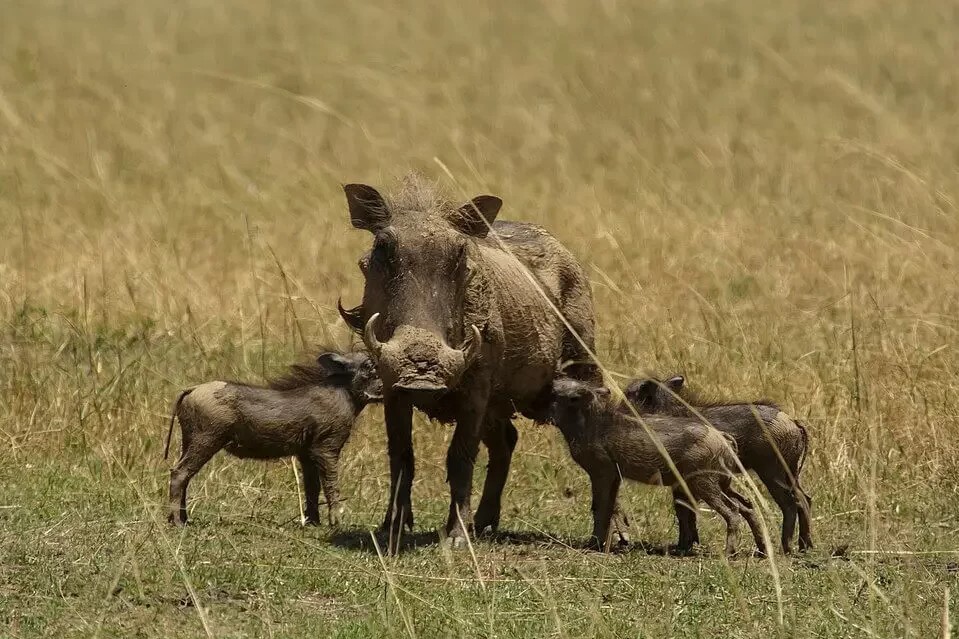The Fascinating World of Warthogs in Uganda: Behavior, Ecology, and Conservation.
Warthogs : Uganda’s Wild Pigs. In the lush savannas and grasslands of Uganda, the warthog stands as a resilient and iconic species. These robust mammals, characterized by their unmistakable facial features and impressive adaptability, play a significant role in the country’s diverse ecosystem.
Species Overview:
Scientifically known as Phacochoerus africanus, the warthog is a wild member of the pig family found in various parts of sub-Saharan Africa. In Uganda, they inhabit a range of environments, from savannas and grasslands to woodlands and semi-desert areas.
Physical Characteristics:
Warthogs boast a unique appearance, recognizable by their bristly manes and prominent facial warts. Despite their formidable appearance, they possess remarkable agility and speed. Adult warthogs typically weigh between 100 to 150 kilograms and stand about 60 to 75 centimeters tall at the shoulder. Their most distinctive features are the sets of upward-curving tusks, which can reach lengths of up to 25 inches (60 centimeters); These tusks serve both as defensive weapons and tools for digging up roots and tubers, a primary component of their diet.
Habitat and Distribution: – Warthogs : Uganda’s Wild Pigs
In Uganda, warthogs thrive in a variety of habitats, including grasslands, woodlands, and semi-arid areas. They can be found in several national parks across the country, such as Murchison Falls National Park, Queen Elizabeth National Park, and Kidepo Valley National Park; Their adaptability allows them to thrive in diverse environments, from open plains to dense bushlands, as long as there’s access to water sources and suitable vegetation for feeding.
Behavior and Social Structure:
Warthogs are predominantly social animals, usually found in family groups called sounders. These groups are typically composed of a female and her offspring, with males often roaming solitarily or forming temporary bachelor groups; Despite their stout appearance, warthogs are surprisingly fast runners, capable of reaching speeds of up to 30 miles per hour (48 kilometers per hour) when threatened; They often seek refuge in abandoned burrows or holes created by other animals to evade predators like lions, leopards, and hyenas.
Diet and Feeding Habits: – Warthogs : Uganda’s Wild Pigs
Warthogs are omnivores with a diverse diet that includes grasses, fruits, roots, and even small animals. Their unique anatomy, with their elongated snouts and tough lips, allows them to kneel and graze close to the ground. While their primary diet consists of vegetation, they are opportunistic feeders and may consume insects or small vertebrates if the opportunity arises.
Conservation Status and Threats:
Warthogs are currently listed as a species of “Least Concern” on the International Union for Conservation of Nature (IUCN) Red List. However, like many African wildlife species, they face threats such as habitat loss, poaching, and human-wildlife conflict. Conservation efforts in Uganda are crucial to ensuring the continued well-being of warthog populations and their ecosystems.
Remarks: – Warthogs : Uganda’s Wild Pigs
In Uganda, warthogs stand as fascinating ambassadors of the country’s diverse wildlife. Their unique appearance, social structure, and adaptability contribute to the rich tapestry of the Pearl of Africa’s natural heritage. As we continue to appreciate and understand these remarkable creatures, it becomes increasingly important to support conservation initiatives that safeguard their future and the biodiversity of Uganda.







